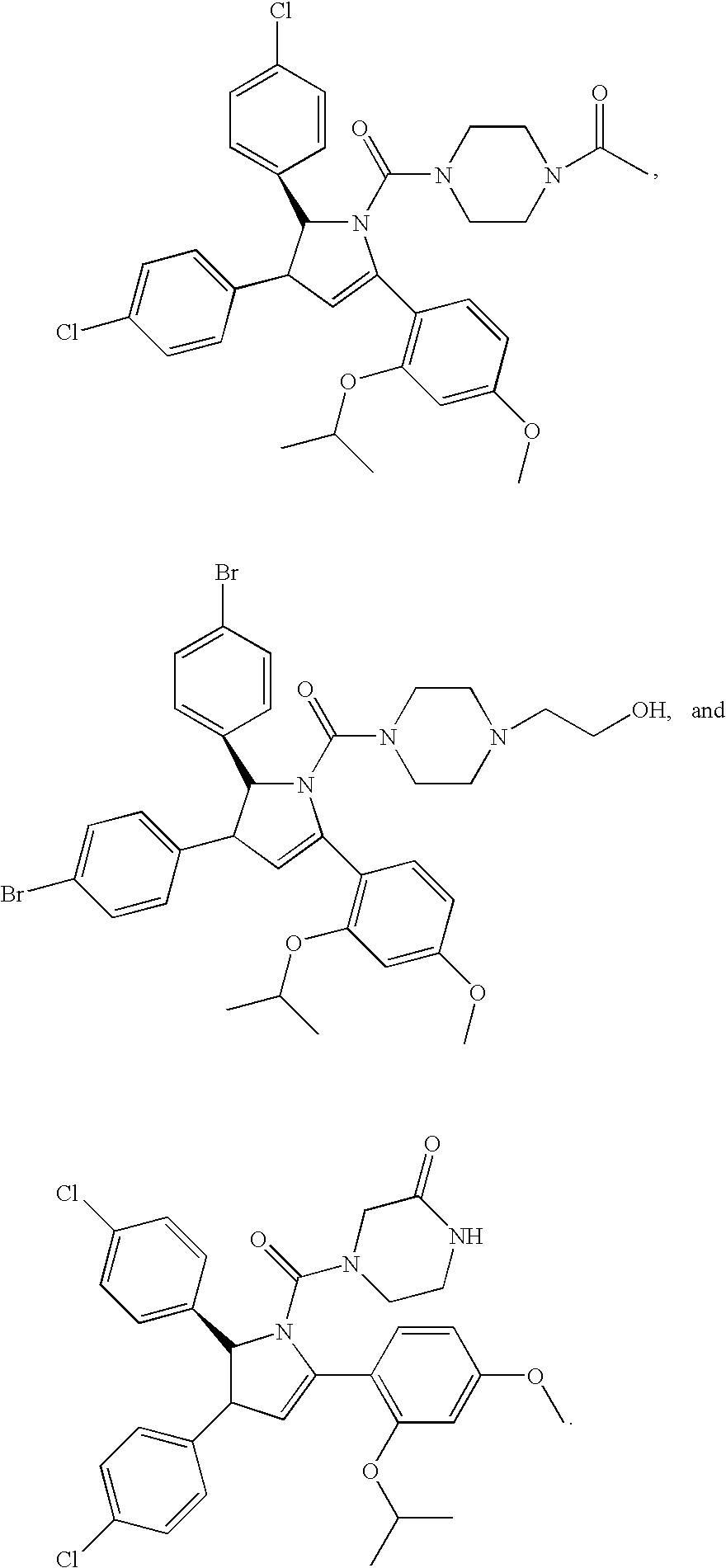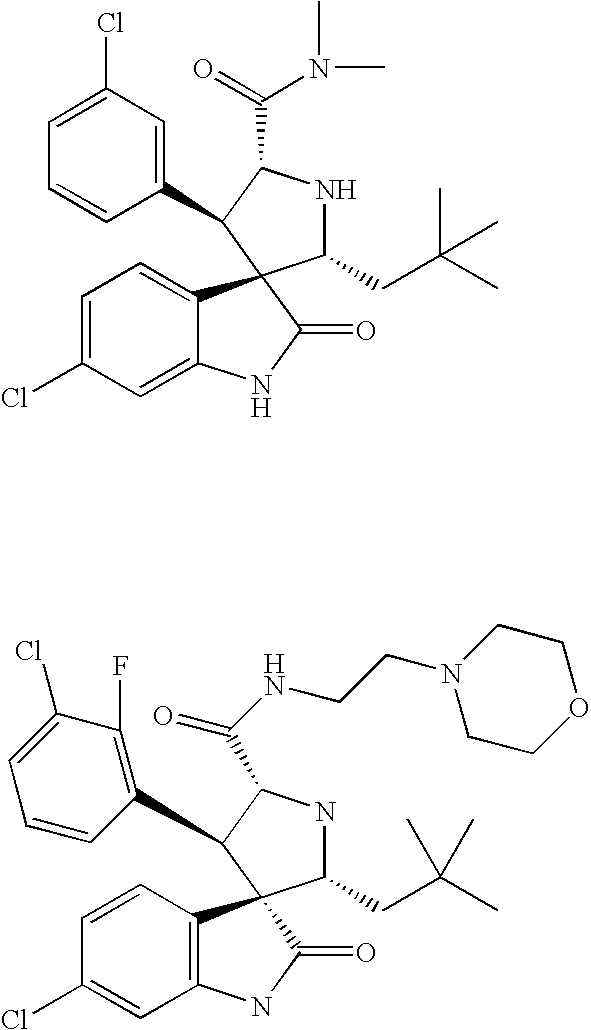Substituted piperidines that increase P53 activity and the uses thereof
a technology of substituted piperidines and p53 activity, applied in the field of compounds, can solve the problems that the loss of the safeguard function of p53 predisposes damaged cells to progress to a cancerous state, and achieves the effect of improving the safety function of p53
- Summary
- Abstract
- Description
- Claims
- Application Information
AI Technical Summary
Benefits of technology
Problems solved by technology
Method used
Image
Examples
example 1
Compound 1
1-Benzyl-3-(4-trifluoromethyl-phenoxy)-piperidine-3-carboxylic acid
[0514]
[0515]1-Benzyl-3-piperidone HCl salt hydrate (33 g, 0.135 mol) was suspended in methylene chloride (200 mL), and triethylamine (21 mL, 0.15 mol) was added to the suspension; which was stirred for three hours. The resultant mixture was washed with H2O (200 mL×2) and 300 mL of brine, then dried over magnesium sulfate, filtered, and the methylene chloride was removed to give 1-Benzyl-3-piperidone.
[0516]Sodium hydroxide (12.1 g, 0.302 mol) was added to stirred solution of 4-hydroxybenzotri-fluoride (5.5 g, 0.034 mol) in anhydrous tetrahydrofuran (165 mL). After 3 h, 1-benzyl-3-piperidone (25.6 g, 0.135 mol) was added to the mixture, the mixture was cooled to 0° C. and anhydrous chloroform (16.5 mL, 0.21 mol) was added dropwise. The reaction mixture was maintained at 0° C. for one hour, allowed to warm to 40° C. for 2˜3 h, then stirred overnight at room temperature. Tetrahydrofuran was removed under reduce...
example 2
Alternative Reaction Route to Compound 19, which is Similar to Compound II Above
[0543]
[0544]Step 1:
[0545]
[0546]4-(Trifluoromethyl)nicotinic acid 15 was dissolved in 20 mL of dimethyl formamide, followed by the addition of O-(Benzotriazol-1-yl)-N,N,N′,N′-tetramethyluronium tetrafluoroborate (TBTU) (3.3 mmol, 1.06 g) and triethylamine (TEA) (3-3 mmol, 460 μL). The mixture was cooled to 0° C., and then 3-Hydroxypiperidine 14 was added. The cooled mixture was stirred at room temperature for 20 hours. The solvent was removed under vacuum. The resulting residue was dissolved in 100 mL of ethyl acetate, and it was washed with saturated sodium bicarbonate and brine successively. The solution was then dried over magnesium sulfate. Removal of the solvent gave a crude product 16 which was purified through a silica gel column chromatography (EtOAc / Hexane=11) (yield, 0.58 g)
[0547]Step 2:
[0548]
[0549]To compound 16 (0.58 g) in dichloromethane (20 mL) at 0° C. was added Dess-Martin periodinane slow...
example 3
[0559]
[0560]Step 1:
[0561]
[0562]To 1-benzyl-3-piperidone HCl salt hydrate (1 eq, 0.111 mol, 25 g) completely dissolved in chloroform (100 mL) and triethylamine (1.1 eq, 0.122 mol, 17 mL) was added methyl chloroformate (1.1 eq, 0.122 mol, 9.4 mL) dropwise at 0° C. After the dropwise addition was complete, additional methyl chloroformate (0.7 eq, 0.078 mol, 6 mL) was added, the reaction mixture warmed to room temperature, and stirred 1 h. The volatiles were removed in vacuo and the resulting residue was taken up in 1N HCl (100 mL) and washed with hexanes (3×70 mL). The aqueous layer was then extracted with ethyl acetate (3×100 mL), the combined ethyl acetate layers washed with brine (1×50 mL), dried (Na2SO4), and concentrated in vacuo to give 23 as an orange oil (10 g), which was used without further purification. Note: If the aqueous layer retains some product, it can be completely extracted using 10% isopropyl alcohol in chloroform.
[0563]Step 2:
[0564]
[0565]To 23 (75.1 mmol, 11.8 g) i...
PUM
| Property | Measurement | Unit |
|---|---|---|
| temperature | aaaaa | aaaaa |
| temperature | aaaaa | aaaaa |
| temperature | aaaaa | aaaaa |
Abstract
Description
Claims
Application Information
 Login to View More
Login to View More - R&D
- Intellectual Property
- Life Sciences
- Materials
- Tech Scout
- Unparalleled Data Quality
- Higher Quality Content
- 60% Fewer Hallucinations
Browse by: Latest US Patents, China's latest patents, Technical Efficacy Thesaurus, Application Domain, Technology Topic, Popular Technical Reports.
© 2025 PatSnap. All rights reserved.Legal|Privacy policy|Modern Slavery Act Transparency Statement|Sitemap|About US| Contact US: help@patsnap.com



